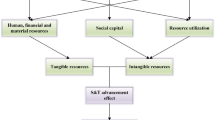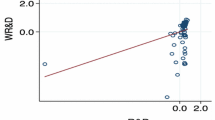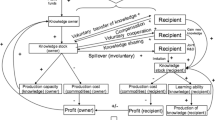Abstract
Griliches’ knowledge production function has been increasingly adopted at the regional level where location-specific conditions drive the spatial differences in knowledge creation dynamics. However, the large majority of such studies rely on a traditional regression approach that assumes spatially homogenous marginal effects of knowledge input factors. This paper extends the authors’ previous work (Kang and Dall’erba in Int Reg Sci Rev, 2015. doi:10.1177/0160017615572888) to investigate the spatial heterogeneity in the marginal effects by using nonparametric local modeling approaches such as geographically weighted regression (GWR) and mixed GWR with two distinct samples of the US Metropolitan Statistical Area (MSA) and non-MSA counties. The results indicate a high degree of spatial heterogeneity in the marginal effects of the knowledge input variables, more specifically for the local and distant spillovers of private knowledge measured across MSA counties. On the other hand, local academic knowledge spillovers are found to display spatially homogenous elasticities in both MSA and non-MSA counties. Our results highlight the strengths and weaknesses of each county’s innovation capacity and suggest policy implications for regional innovation strategies.




Similar content being viewed by others
Notes
We do not model the spillovers of the remaining covariates because, to the best of our knowledge, there is no theoretical foundation to do so. We thank an anonymous referee for raising this point.
We thank an anonymous reviewer for the suggestion of using the number of nearest neighbors chosen by the GWR methodology to set up the flexible spatial extent of local knowledge spillovers across counties.
We do not estimate the distance decay parameter as several previous contributions have done (Burridge and Gordon 1981; Halleck Vega and Elhorst 2015; Pace et al. 1998) nor try to maximize the model’s likelihood based on pre-defined values (as in Kang and Dall’erba 2015) because it would generate different weighting schemes for the local versus distant spillovers thus making them difficult to compare. However, it is an interesting venue for future research as, to our knowledge, parameterizing the distance decay factor has never been done in a local framework like ours.
We thank an anonymous reviewer for suggesting us to try out various kernel functions and distance cut-offs in the definition of the spatial extent of localized spillovers in order to find the best model specification.
The GWR and MGWR calibration results with the other kernel functions are available upon request.
The map of MGWR coefficients of local private knowledge spillovers based on 50 and 75 mile cut-offs is available upon request.
References
Acs Z, Armington C (2004) Employment growth and entrepreneurial activity in cities. Reg Stud 38(8):911–927
Acs ZJ, Audretsch DB, Feldman MP (1994) R&D spillovers and recipient firm size. Rev Econ Stat 76(2):336–340
Acs ZJ, Anselin L, Varga A (2002) Patents and innovation counts as measures of regional production of new knowledge. Res Policy 31(7):1069–1085
Agrawal A, Cockburn I, Rosell C (2010) Not invented here? Innovation in company towns. J Urban Econ 67(1):78–89
Anselin L, Varga A, Acs Z (1997) Local geographic spillovers between university research and high technology innovations. J Urban Econ 42(3):422–448
Anselin L, Varga A, Acs Z (2000) Geographical spillovers and university research: a spatial econometric perspective. Growth Change 31(4):501–515
Arrow KJ (1962) The economic implications of learning by doing. Rev Econ Stud 29(3):155–173
Asheim BT (1996) Industrial districts as ‘learning regions’: a condition for prosperity. Eur Plan Stud 4(4):379–400
Asheim BT, Gertler MS (2006) The geography of innovation: regional innovation systems. In: Fagerberg J, Mowery DC (eds) The Oxford handbook of innovation. Oxford University Press, Oxford, pp 291–317
Asheim B, Isaksen A (2002) Regional innovation systems: the integration of local ‘sticky’ and global ‘ubiquitous’ knowledge. J Technol Transf 27(1):77–86
Audretsch DB, Feldman MP (1996) R&D spillovers and the geography of innovation and production. Am Econ Rev 86(3):630–640
Audretsch DB, Feldman MP (2004) Knowledge spillovers and the geography of innovation. In: Henderson JV, Jacques-François T (eds) Handbook of regional and urban economics, vol 4., ElsevierSan Diego, CA, pp 2713–2739
Autant-Bernard C (2012) Spatial econometrics of innovation: recent contributions and research perspectives. Spat Econ Anal 7(4):403–419
Autant-Bernard C, LeSage JP (2011) Quantifying knowledge spillovers using spatial econometric models. J Reg Sci 51(3):471–496
Bárcena MJ, Menéndez P, Palacios MB, Tusell F (2014) Alleviating the effect of collinearity in geographically weighted regression. J Geogr Syst 16(4):441–466
Bode E (2004) The spatial pattern of localized R&D spillovers: an empirical investigation for Germany. J Econ Geogr 4(1):43–64
Bowman AW (1984) An alternative method of cross-validation for the smoothing of density estimates. Biometrika 71(2):353–360
Brunsdon C, Fotheringham AS, Charlton ME (1996) Geographically weighted regression: a method for exploring spatial nonstationarity. Geogr Anal 28(4):281–298
Brunsdon C, Fotheringham S, Charlton M (1998) Geographically weighted regression-modelling spatial non-stationarity. J R Stat Soc Ser D (The Statistician) 47(3):431–443
Burridge P, Gordon I (1981) Unemployment in the British metropolitan labour areas. Oxford Economic Papers 33(2):274–297
Byrne G, Charlton M, Fotheringham S (2009) Multiple dependent hypothesis tests in geographically weighted regression. In: Lees BG, Laffan SW (eds) The 10th international conference on geocomputation, Sydney, Australia, 30 November–02 December 2009, pp 39–43
Camagni R (1991) Local ‘milieu’, uncertainty and innovation networks: towards a new dynamic theory of economic space. In: Camagni R (ed) Innovation networks: spatial perspectives. Belhaven, London, pp 121–142
Capello R, Lenzi C (2014) Spatial heterogeneity in knowledge, innovation, and economic growth nexus: conceptual reflections and empirical evidence. J Reg Sci 54(2):186–214
Cleveland WS (1979) Robust locally weighted regression and smoothing scatterplots. J Am Stat Assoc 74(368):829–836
Cohen WM, Levinthal DA (1990) Absorptive capacity: a new perspective on learning and innovation. Adm Sci Q 35(1):128–152
Cooke P, Gomez Uranga M, Etxebarria G (1997) Regional innovation systems: institutional and organisational dimensions. Res Policy 26(4–5):475–491
David PA (1994) Why are institutions the ‘carriers of history’? Path dependence and the evolution of conventions, organizations and institutions. Struct Change Econ Dyn 5(2):205–220
Döring T, Schnellenbach J (2006) What do we know about geographical knowledge spillovers and regional growth? A survey of the literature. Reg Stud 40(3):375–395
Duranton G, Puga D (2000) Diversity and specialisation in cities: why, where and when does it matter? Urban Stud 37(3):533–555
Farber S, Páez A (2007) A systematic investigation of cross-validation in GWR model estimation: empirical analysis and monte carlo simulations. J Geogr Syst 9(4):371–396
Feldman MP, Audretsch DB (1999) Innovation in cities: science-based diversity, specialization and localized competition. Eur Econ Rev 43(2):409–429
Feldman MP, Kogler DF (2010) Stylized facts in the geography of innovation. In: Bronwyn HH, Nathan R (eds) Handbook of the economics of innovation, vol 1. North-Holland, Amsterdam, pp 381–410
Fischer MM, Diez JR, Snickars F (2001) Metropolitan innovation systems. Springer, Berlin
Fischer MM, Scherngell T, Jansenberger E (2006) The geography of knowledge spillovers between high-technology firms in Europe: evidence from a spatial interaction modeling perspective. Geogr Anal 38(3):288–309
Florida R (1995) Toward the learning region. Futures 27(5):527–536
Foray D, Lissoni F (2010) University research and public–private interaction. In: Bronwyn HH, Nathan R (eds) Handbook of the economics of innovation, vol 1. North-Holland, Amsterdam, pp 275–314
Fotheringham AS, Brunsdon C, Charlton M (2002) Geographically weighted regression: the analysis of spatially varying relationships. Wiley, Hoboken
Fritsch M, Stephan A (2005) Regionalization of innovation policy—introduction to the special issue. Res Policy 34(8):1123–1127
Fung MK, Chow WW (2002) Measuring the intensity of knowledge flow with patent statistics. Econ Lett 74(3):353–358
Gertler MS, Levitte YM (2005) Local nodes in global networks: the geography of knowledge flows in biotechnology innovation. Ind Innov 12(4):487–507
Glaeser EL, Kallal HD, Scheinkman JA, Shleifer A (1992) Growth in cities. J Polit Econ 100(6):1126–1152
Gollini I, Lu B, Charlton M, Brunsdon C, Harris P (2015) GWmodel: an R package for exploring spatial heterogeneity using geographically weighted models. J Stat Softw 63(17):50
Griliches Z (1979) Issues in assessing the contribution of research and development to productivity growth. Bell J Econ 10(1):92–116
Griliches Z (1992) The search for R&D spillovers. Scand J Econ 94(Supplement):29–47
Guide for public use data files national science foundation’s higher education research and development survey: Fiscal year 2011 (2013) NSF National Center for Science and Engineering Statistics. http://www.nsf.gov/statistics/herd/pub_data.cfm
Hall BH, Jaffe AB, Trajtenberg M (2001) The NBER patent citations data file: Lessons, insights and methodological tools. National Bureau of Economic Research, Cambridge
Halleck Vega S, Elhorst JP (2015) The SLX model. J Reg Sci 55(3):339–363
Harris R (2011) Models of regional growth: past, present and future. J Econ Surv 25(5):913–951
Henderson JV (2003) Marshall’s scale economies. J Urban Econ 53(1):1–28
Hurvich CM, Simonoff JS, Tsai C-L (1998) Smoothing parameter selection in nonparametric regression using an improved Akaike information criterion. J R Stat Soc Ser B (Stat Methodol) 60(2):271–293
Jacobs J (1969) The economy of cities. Random House, New York
Jaffe AB (1986) Technological opportunity and spillovers of R&D: evidence from firms’ patents, profits, and market value. Am Econ Rev 76(5):984–1001
Jaffe AB (1989) Real effects of academic research. Am Econ Rev 79(5):957–970
Jaffe AB, Trajtenberg M, Henderson R (1993) Geographic localization of knowledge spillovers as evidenced by patent citations. Q J Econ 108(3):577–598
Kang D, Dall’erba S (2015) An examination of the role of local and distant knowledge spillovers on the us regional knowledge creation. Int Reg Sci Rev. doi:10.1177/0160017615572888
Keeble D, Lawson C, Moore B, Wilkinson F (1999) Collective learning processes, networking and ‘institutional thickness’ in the Cambridge region. Reg Stud 33(4):319–332
Lazaric N, Lorenz E (1998) Trust and organisational learning during inter-firm cooperation. In: Lazaric N, Lorenz E (eds) Trust and economic learning. Edward Elgar, Cheltenham, pp 209–226
LeSage J, Sheng Y (2014) A spatial econometric panel data examination of endogenous versus exogenous interaction in chinese province-level patenting. J Geogr Syst 16(3):233–262
Liu W-H (2013) The role of proximity to universities for corporate patenting: provincial evidence from China. Ann Reg Sci 51(1):273–308
Lorenz EH (1992) Trust, community and co-operation: toward a theory of industrial districts. In: Scott AJ, Storper M (eds) Pathways to industrialization and regional development. Routledge, London, pp 175–182
Lu B, Charlton M, Harris P, Fotheringham AS (2014a) Geographically weighted regression with a non-euclidean distance metric: a case study using hedonic house price data. Int J Geogr Inf Sci 28(4):660–681
Lu B, Harris P, Charlton M, Brunsdon C (2014b) The GWmodel R package: further topics for exploring spatial heterogeneity using geographically weighted models. Geo-spat Inf Sci 17(2):85–101
Maggioni MA, Uberti TE, Usai S (2010) Treating patents as relational data: knowledge transfers and spillovers across Italian provinces. Ind Innov 18(1):39–67
Mansfield E (1995) Academic research underlying industrial innovations: sources, characteristics, and financing. Rev Econ Stat 77(1):55–65
Marshall A (1920) Principles of economics. Macmillan, London
Maurseth PB, Verspagen B (2002) Knowledge spillovers in Europe: a patent citations analysis. Scand J Econ 104(4):531–545
McMillen DP (2010) Issues in spatial data analysis. J Reg Sci 50(1):119–141
McMillen DP, Redfearn CL (2010) Estimation and hypothesis testing for nonparametric hedonic house price functions. J Reg Sci 50(3):712–733
Mei CL, Wang N, Zhang WX (2006) Testing the importance of the explanatory variables in a mixed geographically weighted regression model. Environ Plan A 38(3):587–598
Moreno R, Miguélez E (2012) A relational approach to the geography of innovation: a typology of regions. J Econ Surv 26(3):492–516
Morgan K (1997) The learning region: institutions, innovation and regional renewal. Reg Stud 31(5):491–503
Mukherji N, Silberman J (2013) Absorptive capacity, knowledge flows, and innovation in U.S. metropolitan areas. J Reg Sci 53(3):392–417
Ó hUallacháin B, Leslie TF (2007) Rethinking the regional knowledge production function. J Econ Geogr 7(6):737–752
Oughton C, Landabaso M, Morgan K (2002) The regional innovation paradox: innovation policy and industrial policy. J Technol Transf 27(1):97–110
Pace RK, Barry R, Clapp JM, Rodriquez M (1998) Spatiotemporal autoregressive models of neighborhood effects. J Real Estate Finance Econ 17(1):15–33
Paez A, Farber S, Wheeler D (2011) A simulation-based study of geographically weighted regression as a method for investigating spatially varying relationships. Environ Plan A 43(12):2992–3010
Parent O (2012) A space-time analysis of knowledge production. J Geogr Syst 14(1):49–73
Parent O, LeSage JP (2008) Using the variance structure of the conditional autoregressive spatial specification to model knowledge spillovers. J Appl Econ 23(2):235–256
Partridge MD, Rickman DS, Ali K, Olfert MR (2008) The geographic diversity of U.S. nonmetropolitan growth dynamics: a geographically weighted regression approach. Land Econ 84(2):241–266
Peri G (2005) Determinants of knowledge flows and their effect on innovation. Rev Econ Stat 87(2):308–322
Ponds R, Fv Oort, Frenken K (2010) Innovation, spillovers and university–industry collaboration: an extended knowledge production function approach. J Econ Geogr 10(2):231–255
Romer PM (1986) Increasing returns and long-run growth. J Polit Econ 94(5):1002–1037
Rosenkopf L, Almeida P (2003) Overcoming local search through alliances and mobility. Manage Sci 49(6):751–766
Simmie J (2011) Learning regions. In: Cooke P, Asheim B, Boschma R, Martin R, Schwartz D, Tödtling F (eds) Handbook of regional growth and innovation. Edward Elgar, Cheltenham, pp 547–555
Smallen D (2004) 3.3 million Americans are stretch commuters traveling at least 50 miles one-way to work. United States Department of Transportation. https://www.rita.dot.gov/bts/sites/default/files/rita_archives/bts_press_releases/2004/bts010_04/html/bts010_04.html. Accessed 16 Nov 2014
Standard & Poor’s (2011) Standard & poor’s compustat® xpressfeed understanding the data. The McGraw-Hill Companies, Inc., Centennial, CO
Storper M (1993) Regional “worlds” of production: learning and innovation in the technology districts of France, Italy and the USA. Reg Stud 27(5):433–455
Storper M (1997) The regional world: territorial development in a global economy. Guilford Press, New York, NY
Stough RR (2003) Strategic management of places and policy. Ann Reg Sci 37(2):179–201
Trippl M, Tödtling F, Lengauer L (2009) Knowledge sourcing beyond buzz and pipelines: evidence from the Vienna software sector. Econ Geogr 85(4):443–462
USPTO (2010) Patents BIB: Selected bibliographic information from US patents issued 1969 to present. Alexandria, VA
Verspagen B, Schoenmakers W (2004) The spatial dimension of patenting by multinational firms in europe. J Econ Geogr 4(1):23–42
Wei C-H, Qi F (2012) On the estimation and testing of mixed geographically weighted regression models. Econ Model 29(6):2615–2620
Wheeler D, Tiefelsdorf M (2005) Multicollinearity and correlation among local regression coefficients in geographically weighted regression. J Geogr Syst 7(2):161–187
Zysman J (1994) How institutions create historically rooted trajectories of growth. Ind Corp Change 3(1):243–283
Acknowledgments
We would like to thank the Editor-in-Chief Dr. Manfred M. Fischer and two anonymous reviewers for their helpful comments and suggestions.
Grant
This study was supported by the National Science Foundation Grant (SMA-1158172). Any opinions, findings and conclusions or recommendations expressed in this article are those of the authors and do not necessarily reflect the views of the National Science Foundation.
Author information
Authors and Affiliations
Corresponding author
Rights and permissions
About this article
Cite this article
Kang, D., Dall’erba, S. Exploring the spatially varying innovation capacity of the US counties in the framework of Griliches’ knowledge production function: a mixed GWR approach. J Geogr Syst 18, 125–157 (2016). https://doi.org/10.1007/s10109-016-0228-8
Received:
Accepted:
Published:
Issue Date:
DOI: https://doi.org/10.1007/s10109-016-0228-8
Keywords
- Knowledge production function
- Knowledge spillovers
- Spatial heterogeneity
- Mixed geographically weighted regression (MGWR)




